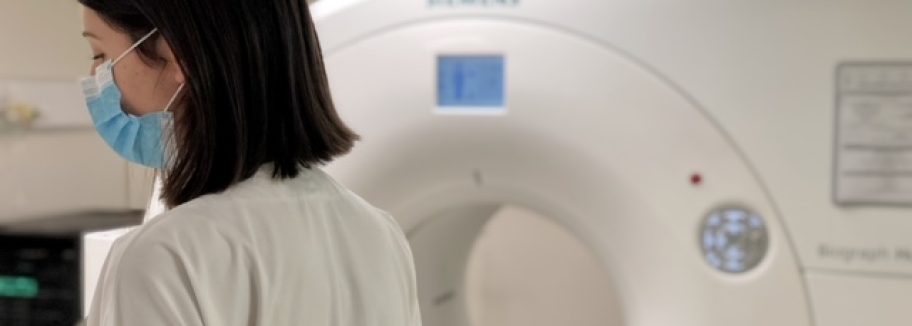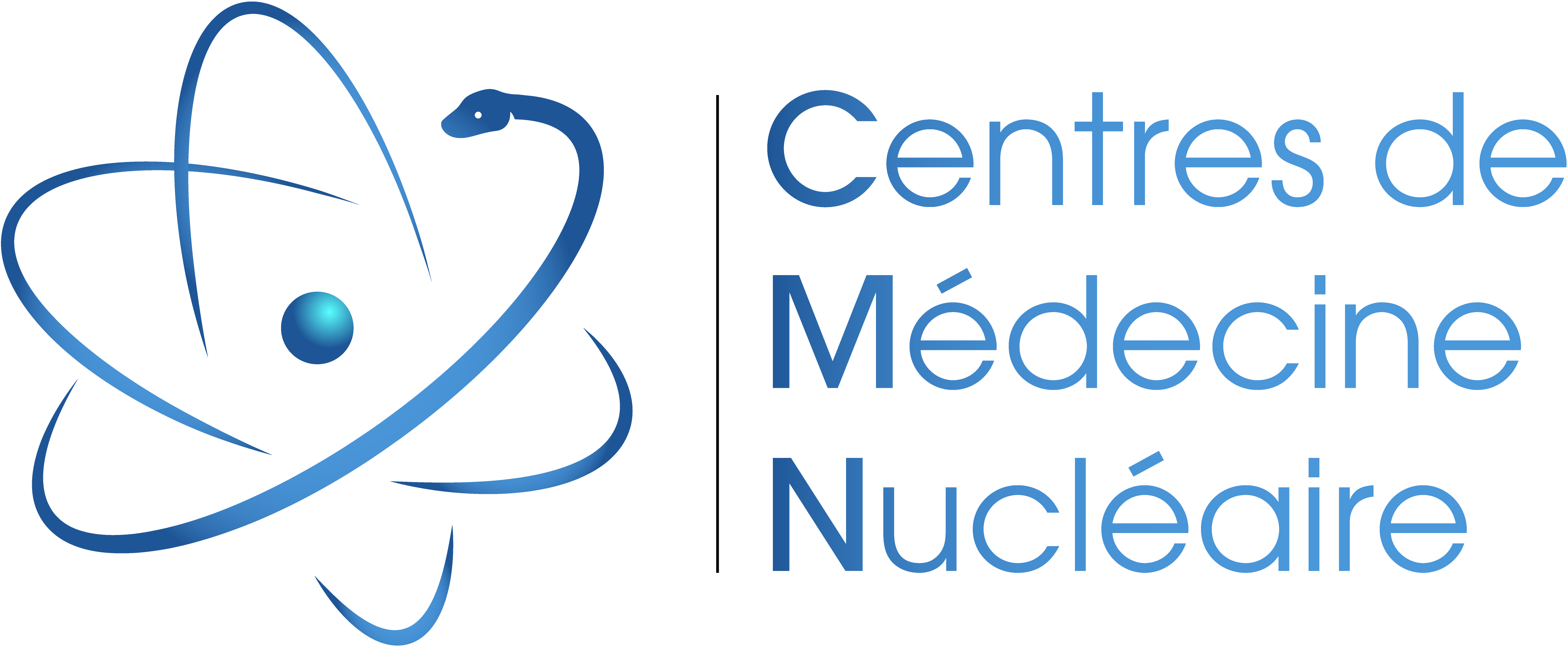PET-CT
Home > PET-CT

Our rates
Doctors licensed as sector 1 approved
No extra fees
CMU (French universal medical cover) & AME (French state medical aid) accepted
Payment of the examination
€26.86 except if 100% ALD (long-term illness) coverage
Payment methods accepted :
credit/debit card, cheque, cash
What is a PET-CT scan?
Positron emission tomography coupled with a CT scan (PET-CT) is a medical imaging method used by nuclear medicine departments. It enables the metabolic or molecular activity of an organ to be measured in three dimensions thanks to the emissions produced by the positrons from a radioactive product injected beforehand. These images are then merged with a scan (CT) so as to provide precise localisation for the examination.
PET scans are based on the general principle of scintigraphy, which consists of injecting a tracer with known biological properties and behaviour to obtain an image of the functioning of an organ or the presence of a molecular target. This tracer is marked by a radioactive atom (mainly Fluorine 18) which emits positrons whose annihilation produces two photons. The simultaneous detection of these photons enables the localisation of the site of their emission as well as the concentration of the tracer at each point of the organ. It is this quantitative information that is represented in the form of an image displaying the areas of high tracer concentration in colour.
What happens during a PET-CT scan?
Select your examination
What is an 18F-FDG PET-CT scan?
PET is a medical imaging method that measures the metabolic activity of an organ using a radioactive product that is injected beforehand. These PET images are then merged with a scan (CT or x-ray computed tomography) to obtain a very precise localisation of the abnormalities. 18F-FDG (fluorine-18 coupled with fluorodeoxyglucose) is a very sensitive radioactive tracer used to diagnose or assess lesions of many types of cancer but is also used to look for signs of infectious diseases and certain inflammatory diseases.
Instructions for this examination
• Make sure you are available for 3 hours
• Do not eat or drink anything for 6 hours before your examination, 4 hours before if you are diabetic
• However, you can still drink plain, unsweetened water and take your usual medication
• If you are pregnant, think you might be pregnant or are breastfeeding: please let us know, as the examination may need to be postponed after medical advice
• Bring a snack for the end of the examination
On the day of your examination do not forget
• Your French health insurance card ("carte Vitale")
• Your credit/debit card or a cheque for payment of the examination (€26.86), except if you have 100% insurance coverage
• Your previous examinations (PET, scintigraphy, X-ray, CT scan, MRI, ultrasound, etc.)
1 - ARRIVAL AT THE DEPARTMENT
Welcome, medical validation and administrative formalities at the secretarial desk
2 - YOU GO ALONE INTO THE "HOT" WAITING AREA
Unaccompanied entry into a restricted area
3 - YOU SEE A RADIOLOGY TECHNICIAN
Questioning in relation to your prescription and placement of an intravenous infusion in the arm
4 - INJECTION OF THE TRACER
by infusion in the arm
5 - 1 HOUR OF REST
in the dark to ensure proper fixation of the product
6 - ACQUISITION OF IMAGES
using a PET-CT camera for 15-20 minutes
7 - IMAGE RECONSTRUCTION AND VERIFICATION
if necessary, additional images are taken 5 to 10 minutes after the end of the examination
8 - Availability of results
After analysis and double reading of the images by two nuclear medicine physicians, and after they have written up their report, your results will be sent to your prescribing doctor the following working day.
After your examination
The small amount of radioactive product injected does not cause any side effects. The residual radioactivity that remains after the examination is eliminated naturally and this can be accelerated by drinking. You can eat normally and may return to work or any other activity. In addition, you can remain in contact with other people, including pregnant women and young children.
What is an 18F-DOPA PET-CT scan?
PET is a medical imaging technique that measures the metabolic activity of an organ using a radioactive product that is injected beforehand. These PET images are then merged with a scan (CT or x-ray computed tomography) to obtain a very precise localisation of abnormalities. 18F-DOPA (fluorine 18 coupled with DOPA) is a very sensitive radioactive tracer used to diagnose or assess lesions in certain types of cancer, particularly neuroendocrine tumours (excluding the pancreas).
CInstructions for this examination
• Make sure you are available for 3 hours
• Do not eat or drink anything for 6 hours before your examination, 4 hours before if you are diabetic
• However, you can still drink plain, unsweetened water and take your usual medication
• If you are pregnant, think you might be pregnant or are breastfeeding: please let us know, as the examination may need to be postponed after medical advice
• Bring a snack for the end of the examination
On the day of your examination do not forget
• Your French health insurance card ("carte Vitale")
• Your credit/debit card or a cheque for payment of the examination (€26.86), unless you have 100% insurance coverage
• Your previous examinations (PET, scintigraphy, X-ray, CT scan, MRI, ultrasound, etc.)
1 - ARRIVAL AT THE DEPARTMENT
Welcome, medical validation and administrative formalities at the secretarial desk
2 - YOU GO ALONE INTO THE "HOT" WAITING AREA
Unaccompanied entry into a restricted area
3 - YOU SEE A RADIOLOGY TECHNICIAN
Questioning in relation to your prescription and placing of an intravenous infusion in the arm
4 - INJECTION OF THE TRACER
by the infusion to the arm, possibly followed by a first 5-minute image centred on the study area
5 - 1 HOUR AT REST
in the dark to ensure proper fixation of the product
6 - ACQUISITION OF IMAGES
using a PET-CT camera for 15-20 minutes
7 - IMAGE RECONSTRUCTION AND VERIFICATION
if necessary, additional images are taken 5 to 10 minutes after the end of the examination
8 - Availability of results
After analysis and double reading of the images by two nuclear medicine physicians, and after they have written up their report, your results will be sent to your prescribing doctor the following working day.
After your examination
The small amount of radioactive product injected does not cause any side effects. The residual radioactivity that remains after the examination is eliminated naturally and this can be accelerated by drinking. You can eat normally and may return to work or any other activity. In addition, you can remain in contact with other people, including pregnant women and young children.
What is an 18F-Choline PET-CT scan?
PET is a medical imaging technique that measures the metabolic activity of an organ using a radioactive product that is injected beforehand. These PET images are then merged with a scan (CT or x-ray computed tomography) to obtain a very precise localisation of the abnormalities. 18F-Choline (fluorine 18 coupled with Choline) is a very sensitive radioactive tracer used to diagnose or assess lesions of certain types of cancer, particularly of the prostate. This tracer is also used in endocrinology, in the case of hyperparathyroidism, to look for abnormalities in the functioning of the parathyroid glands (such as parathyroid adenoma or parathyroid hyperplasia).
Instructions for this examination
•Make sure you are available for 3 hours
• Do not eat or drink anything for 4 hours before your examination
• However, you can still drink plain, unsweetened water and take your usual medication
• Bring a snack for the end of the examination
On the day of your examination do not forget
• Your French health insurance card ("carte Vitale")
• Your credit/debit card or a cheque for payment of the examination (€26.86), except if you have 100% insurance coverage
• Your previous examinations (PET, scintigraphy, X-ray, CT scan, MRI, ultrasound, etc.)
PLEASE NOTE
As Choline is produced in the hours prior to your examination, in the event of pharmacological non-compliance or production failure by our industrial supplier, we may need to reschedule your appointment (at the earliest possible date).
1 - ARRIVAL AT THE DEPARTMENT
Welcome, medical validation and administrative formalities at the secretarial desk
2 - YOU GO ALONE INTO THE "HOT" WAITING AREA
Unaccompanied entry into a restricted area
3 - YOU SEE A RADIOLOGY TECHNICIAN
Questioning in relation to your prescription and placing of an intravenous infusion
4 - INJECTION OF THE TRACER
intravenously in the arm
5 - 30 MIN AT REST (OR ONLY 5 MIN IF PARATHYROID EXAMINATION)
to ensure proper fixation of the product
6 - ACQUISITION OF IMAGES
using a PET-CT camera for 15-20 minutes
7 - RECONSTRUCTION AND VERIFICATION OF IMAGES BY THE NUCLEAR MEDICINE PHYSICIAN
if necessary, additional images are taken 5 to 10 minutes after the end of the examination
8 - Availability of results
After analysis and double reading of the images by two nuclear medicine physicians, and after they have written up their report, your results will be sent to your prescribing doctor the following working day.
After your examination
The small amount of radioactive product injected does not cause any side effects. The residual radioactivity that remains after the examination is eliminated naturally and this can be accelerated by drinking. You can eat normally and may return to work or any other activity. In addition, you can remain in contact with other people, including pregnant women and young children.
Have you been prescribed a PET-CT scan, but are not sure what type of examination you need?
Don't worry, our Nuclear Medicine Centres will be pleased to answer all your questions.
Would you like an answer directly by phone?
Contact your nearest centre click here
Would you like an answer directly by email?
Write to us via the contact form by selecting the centre closest to you click here
